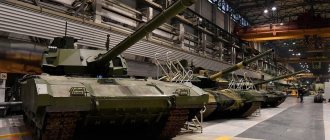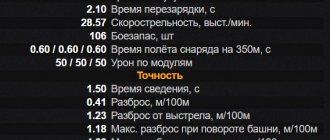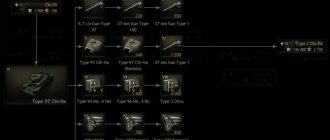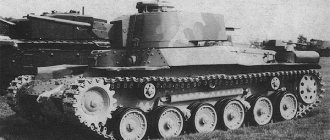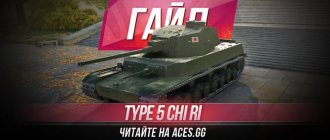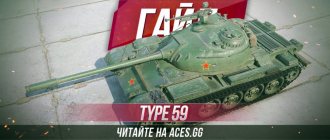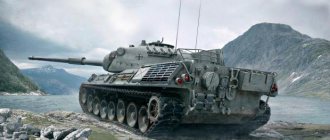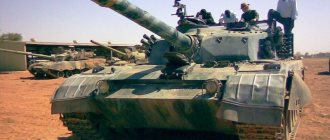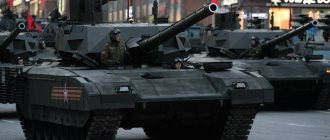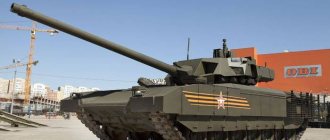Characteristics of the main tank Toure 69
A country:ChinaType:Main tankDate of issue:1969 u/Length:8.66 mWidth:3.27 mHeight:2.8 mArmor, forehead:100 mmArmor, side:80 mmArmor, tower:up to 200 mmCrew:4 peopleEngine:Diesel 12150L-7B, 580 hp.Travel range:440 kmMaximum speed:50 km/hWeight:36.7 tonsWeapons:1x 100 mm Toure 59-1 cannon (44 rounds), 2x 7.62 mm Toure 59T machine gun (3000 rounds), 1x 12.7 mm Toure 54 anti-aircraft machine gun (500 rounds).
Specifications shown for Type 69-II
Tactics
Despite being classified as a “medium tank,” the Type 69 is difficult to use for breakthroughs due to its low mobility. Within its tier it is the least mobile vehicle, having other advantages such as stronger armor on the gun turret.
Advantages and disadvantages
When reading the advantages and disadvantages below, do not forget that they are formed based on a comparison of military equipment of the same class at the second level!
Advantages:
- A powerful weapon.
- Acceleration.
- Hull rotation speed.
Flaws:
- Low maximum speed among all second-tier tanks.
- Weaker armor.
- Low turret rotation speed.
- Aiming time.
Upgrades
Since we are talking about a second-tier tank, you shouldn’t expect a huge variety of improvements. Therefore, we pump everything we see. And we see the possibility of improving the TDA system (instead of two smoke screens, five will be available), the rangefinder (-10% spread), the charging system (+10% to the reload speed) and the engine (a small plus to acceleration and about 10% to the hull rotation speed — the maximum speed remains the same as in the basic configuration).
Available upgrades
Commander and crew skills
• Commander: Juan Carlos to improve aiming speed and crew stats. • Driver: Off-road driving. • Gunner: Marksman. • Loader: Rapid fire, explosive rounds.
History of the Type 69 tank
The Chinese Type 69 tank is a modernized export version of the Type 59 tank made by NORINCO at the very end of the 1960s. Overall, the vehicle represents the Chinese interpretation of the Soviet T-62. Despite the existing experience and the well-known original model, the car turned out to be very “capricious” and its development took more than a decade, so the first “release” of the Type 69 occurred only in 1982.
Beginning in 1983, the production and export of combat vehicles were established serially - in the same year, Iraq alone purchased several hundred Type 69 tanks at once, and in the period until 1987, this country acquired up to 2,000 such tanks (out of 2,500 supplied by China to the Middle East). East). In addition, major buyers were:
- Pakistan: purchased 250 Type 69 tanks, and then began producing under license (from 1993) under its own designation "Type 69-IIMP".
- Bangladesh: 232 tanks (1998).
- Thailand: 50 tanks (1987), own designation "Ture 30 MW".
- Sri Lanka (no information).
Bottom line
Chang Feng's low-level technique is very specific. This is due to the fact that China began to catch up with other countries in the tank arms race relatively late. So we have a Type 69 combat unit on the second tier, designed on an outdated platform, but equipped with modern technologies.
It is easy to notice strong similarities in performance characteristics with the Russian T-55 (this trend is observed for all Chinese tanks of the lower and middle levels), but still this technique is focused on high damage from one shot, which is associated with poor mobility. The Type 69 is a slow and poorly protected tank with a good combat weapon.
Type 69 tank design
Structurally, the Type 69 is the same as the Type 59, but with an improved fire control system and a new gun. The 100-mm smoothbore gun “69” was developed in China on the basis of the rifled gun “59” and the study of the Soviet 115-mm Soviet U-5TS gun, from the T-62 tank that was inherited by the Chinese side during the conflict near Damansky Island in 1968.
The fire control system features a two-plane stabilizer, allowing targeted shooting on the move. Lamps are used as the element base of the stabilizer, which naturally looks like a rather strange choice in the era of semiconductors. The same system includes a laser rangefinder Toure 82 (Yangzhu) from CELEC, installed above the gun mantlet (accuracy up to 10 meters at distances up to 3 km). The tank is equipped with active type night vision devices (again, a copy of the Soviet ones). Instead of the Type 59 observation device, a transscopic gunner's sight with day and night channels is mounted.
The tank is equipped with an “889” radio station with a communication range of up to 25 km and an “883” intercom (of course, a copy of the Soviet one), as well as a semi-automatic fire extinguishing system.
Diagram of the Chinese tank "Type 69"
Tips for the game.
On this tank, you can and should use armor on the front of the turret. If you correctly position the front of the turret and hide the hull, then you can tank some good damage on it. It is also worth noting the excellent 121 gun, which has the highest one-time damage among all tier 10 medium tanks. Yes, and the gun’s penetration is excellent, but the shooting accuracy on the move leaves much to be desired. Yes, shooting on the move at an enemy from 100 m you will most likely hit, but from 150 m this is already in question. Therefore, in duels against classmates, a tank can easily lose, since a competent enemy will not clinch 121 and penetrate the 240 mm of armor on the turret’s forehead, but will maneuver, forcing the Chinese to move. And while moving, you will not be able to target the enemy’s vulnerable spots.
Speaking of dynamics, the tank can easily be compared with the T-62A, they are similar, but the Chinese are much inferior to the Bat Chatillon 25 t. Therefore, we will be able to change directions and occupy key places on the map.
After the advent of physics and new rendering in general, all the old maps were “dug up”, which means that tanks with good aiming angles became in great demand, which of course does not apply to the 121. The tank has terrible UVN, it’s like the French armor - there is none ! Therefore, choose firefight locations where you won't have to roll over a hill and take massive damage because the gun won't go down. The tank is ideal for urban battles.
To sum up, the tank is very versatile: it can butt heads with heavies due to its armor, spin tanks due to its dynamics, and duel with medium tanks due to its huge one-time damage.
Modifications and variants of the Type 69 tank
- Tour 69 (WZ121) - (1971-1982) basic version. Combat weight 36.5 tons, 150 units manufactured.
- Toure 69-1 - advanced infrared equipment, protection system against weapons of mass destruction.
- Type 69-II (WZ121A, 1983) - basic model with a 100-mm rifled gun "59-11", an improved fire control system Image-Stabilized Fire Control System-212, a stabilized gunner's sight TGS-A, an electronic ballistic computer, a system of input information sensors, a laser range finder, and a two-plane gun stabilizer. The tank is equipped with five-section anti-cumulative side screens.
- Type 69-IIB (WZ121B) - export command tank with two "889" radios. There is no front-mounted machine gun.
- Type 69-IIC - command tank with two radios "889" and "882", and additional field telephone equipment in containers at the stern.
- Type 69-IIG - modification for Iraq with lattice screens around the perimeter of the turret (at the same time baskets for equipment), and 2 blocks of 4-barrel smoke grenade launchers on the sides of the turret. There is no frontal machine gun.
- Toure 79 (Type 69-III, WZ121D, 1984) - a deep modernization of the Type 69 tank with a 105-mm Toure 83 (L7A3) gun, equipped with an ejector and a heat-protective casing, however, manual loading. Fire control system ISCFS-212 (Type 37A), including a laser rangefinder and a ballistic computer (data is entered manually, based on the indicators of the built-in sensors). Compared to the Toure 69 tank, the shape of the turret has been changed, 4x 76-mm smoke grenade launchers and boxes of spare parts and tools have been installed. There is no frontal machine gun. Side screens are installed, a 12150L-7BW diesel engine with a power of 730 hp is used. The tank's combat weight is 37.5 tons, maximum speed is 50 km/h. 500-800 units produced.
Tank "Type 69-IIG" for the Iraqi army - the lattice screens on the turret are clearly visible
Introduction
The Type 69 is a Tier 2 main battle tank from Chang Feng, classified as a medium tank, with several advantages:
- Better armor and safety margin compared to other classes of equipment.
- Powerful large-caliber gun.
First PvP battle on the improved Type 69
In Chan Feng's branch, this is the only vehicle at the second level, and its main competitors are tanks of the same class M48A3 and T-55 from Sophie Wölfli and Marat Shishkin. In addition to these tanks, the Scimitar (Shishkina) and Lav-150 armored fighting vehicles, the light regular T92LT and the premium T92 ACAV tank (all from Sophie Wölfli) are also available at the second level.
Basic information:
- Level - second.
- Class - main battle tank.
- Country: China.
- Supplier - Chang Feng.
- Reputation - 7200.
- Cost: 12,000 credits.
Options for combat vehicles based on the Type 69 tank
BREM Toure 653 (WZ653A)
Armored repair and recovery vehicle based on the Type 69 tank. Instead of the turret, there is a rectangular deckhouse welded from armor plates (for 4 crew members). There are three hatches in the roof of the cabin: one large rectangular and two round ones, which are standard turrets from the “69” tank with prismatic viewing devices. A turret with a 12.7 mm “54” machine gun is installed above the left hatch.
In front to the right of the wheelhouse, a hydraulically driven crane is mounted on the roof of the hull. At the front of the body there is a bulldozer blade. The machine is equipped with two winches, one of which (the main one) has a traction force of up to 70 tons, and welding equipment.
The driver sits on the front left; a small armored cabin is mounted above his seat with a sunroof that opens to the rear and a viewing glass block in front, which can be closed with an armored lid with a slot. Tool boxes are located on the left fender shelf.
Crew 5 people, combat weight 38 tons, stowed height 2.34 m, diesel engine power 580 hp, maximum highway speed 50 km/h, cruising range up to 450 km. On-board screens were installed on the latest series vehicles.
ARVs are in service with China, Bangladesh, Iraq (status unclear), Kuwait and Thailand.
Tank "Type 69-II" Pakistan Army
Bridgelayer Ture 84 (WZ621)
Tank bridge layer based on a chassis based on the Type 69 tank. Instead of a turret, a retractable two-section bridge track structure (like the German Biber based on the Leopard 1 tank) is installed on the top of the hull, which can be installed either through the bow or through the stern side of the vehicle. Bulldozer equipment is mounted ahead to clear approaches to the barrier, passages in rubble and non-explosive obstacles, trenches for military equipment and self-digging. The control system for the bridge mechanism and bulldozer equipment is hydraulic. To unload the undercarriage of the bridge paver, the front part of the chassis rests on the dozer blade. The entire operation of building a bridge takes 3-4 minutes.
The load capacity of the bridge is up to 40 tons. The combat weight of the bridge layer is 38 - 38.5 tons, the crew is 2 - 3 people, the maximum speed on the highway is up to 50 km/h, the cruising range is 365 km. The 7.62 mm "59" machine gun is used as a defensive weapon.
